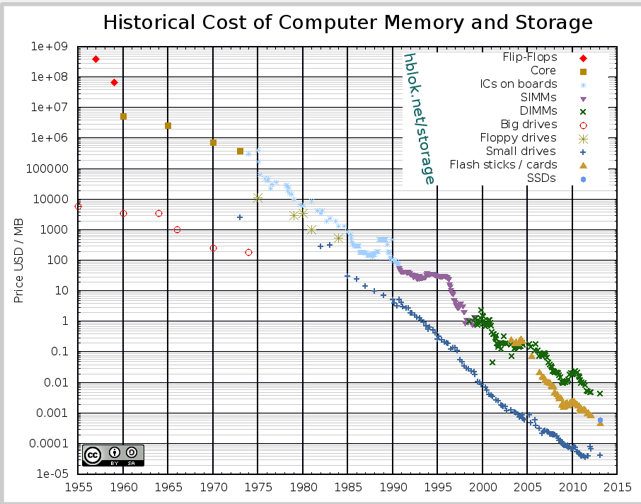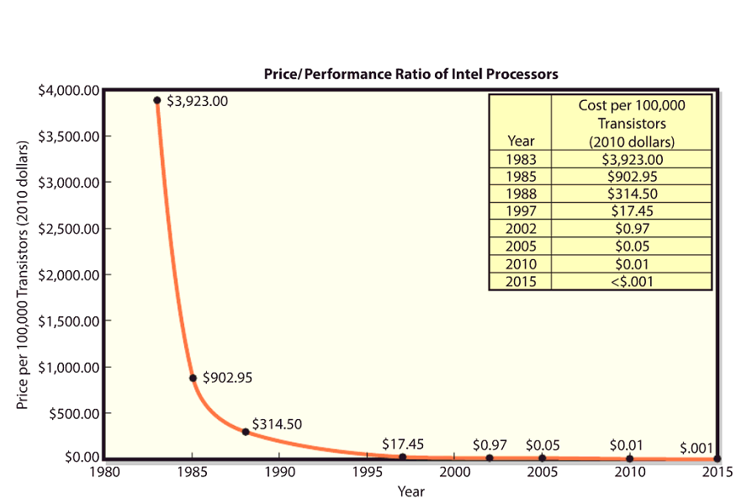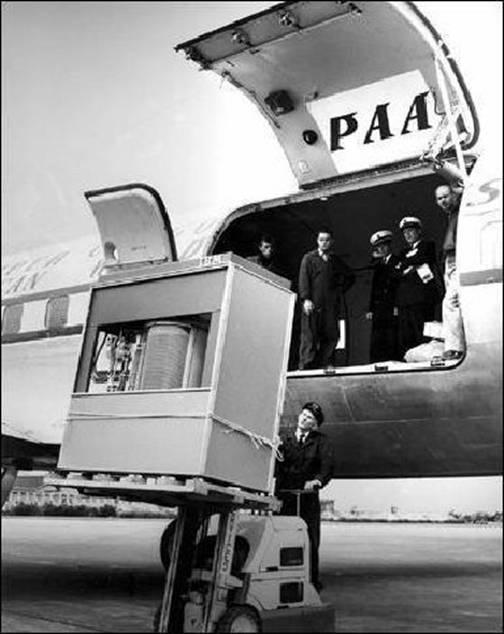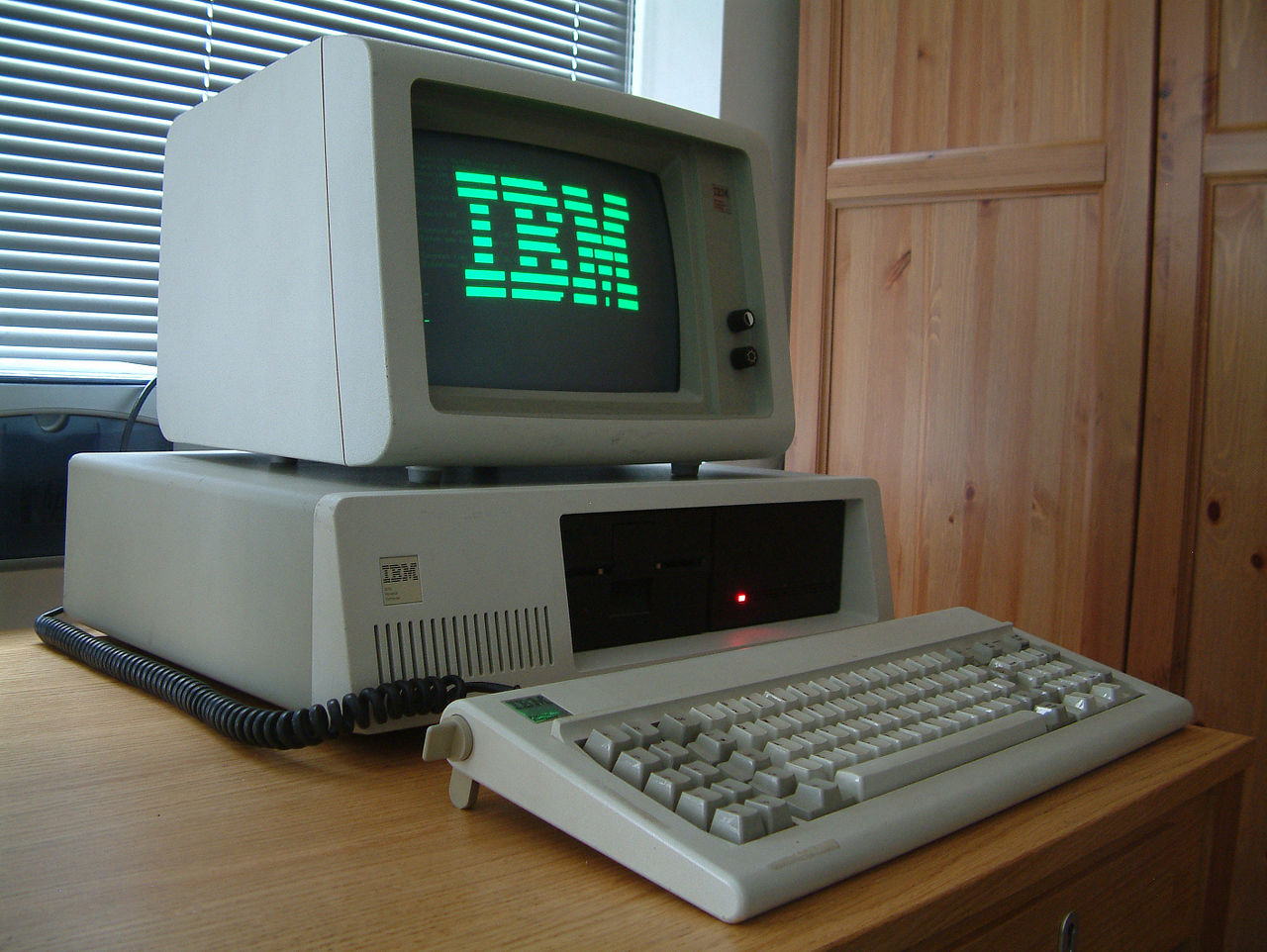Cost of Data – Why are the world’s data stores growing so fast?
Cost of Data, Is Data cheap?
The Digital Revolution – Moore’s Law
In 1965, Gordon Moore, Co-Founder of Intel, stated that due to technology improvements in chip design and manufacturing “The number of transistors per square inch on an integrated chip doubles every 18 months.” This has been commonly misunderstood to be that the speed of a computer doubles every 18 months.
Following Moore’s Law the price to performance ratio of computers has fallen exponentially over the last 50 years with no end in sight.
Because of Moore’s this law the cost of data processing is approaching zero.
Why does Moore’s Law work?
Making a semiconductor
- Magic Silicon
- Grow a wafer – crystal structure
- Slice Wafer
- Photolithography to make circuits
- Dice
- Package
- How many circuits on a wafer?

| Description | Image:Wafer 2 Zoll bis 8 Zoll.jpg uploaded by Saperaud |
|---|---|
| Source | German Wikipediabiatch, original upload 7. Okt 2004 by Stahlkocher de:Bild:Wafer 2 Zoll bis 8 Zoll.jpg |
| Author | |
| Other versions | Derivative works of this file: Portal Mikroelektronik Banner.jpg |
| Year | Cost (Per Gigabyte) |
|---|---|
| 1980 | $437,500 |
| 1985 | $105,000 |
| 1990 | $11,200 |
| 1995 | $1,120 |
| 2000 | $11.00 |
| 2005 | $1.24 |
| 2010 | $0.09 |
| 2013 | $0.05 |
| 2014 | $0.03 |
| 2015 | $0.022 |
| 2016 | $0.019 |


In September 1956 IBM launched the 305 RAMAC, the first computer with a hard disk drive (HDD). The HDD weighed over a ton and stored 5MB of data.
Hard Drive = data stored on a magnetic disk and accessed via a moving head.
Unprecedented random-access storage — 5 million characters (not bytes, they were 7-bit, not 8-bit characters). This first disk drive heralded startling leaps in mass-storage technology and the end of sequential storage on punched cards and paper or Mylar tape, though magnetic tape would continue for archival or backup storage.

IBM 305 at U.S. Army Red River Arsenal, with two IBM 350 disk drives in the foreground
Guess what it is!

Title: “Guess what it is!”
Author: Insomnia Cured Here
Attribution-NonCommercial-ShareAlike 2.0 Generic (CC BY-NC-SA 2.0)
This is a picture of an IBM hard drive being loaded onto an airplane in 1956. It’s a 5 mega-byte drive, and it weighed more than 2,000 pounds.
To put that in context, 55 years later, the weakest iPhone 5S has a 16 gigabyte drive, about 3,200-times as big. It weighs a quarter of a pound.
The IBM hard drive could have stored exactly one iPhone picture.
Anyone know what this is? How big was the hard drive?

IBM PC with MDA monitor
IBM PC XT with green monochrome phosphor screen and 10MB full height 5,25″ hard disk drive
Attribution 3.0 Unported (CC BY 3.0)
IBM PC XT with green monochrome phosphor screen and 10MB full height 5,25″ hard disk drive.
Hard drive could be either 10 or 20 Megabytes.
The decreasing cost of storing data over time enables the notion that information about transactions may have more value than the transactions themselves.
Some examples to discuss::
- Traffic – Cell phone Transactions
- Diapers and Beer
- Airline Guide vs Airlines
- TV Guide vs TV Networks
- Chip in Car – Insurance – What is the transaction?
- Speed Habits
- Immediate Accident reporting
- Google Search “Influenza”
- Telephone data 9/11
- AT&T Grocery Delivery (Database)
- Pandora – restaurant playlist
- Records – Tapes – CD’s – Download (Napster) – Playlists – Plays
- Mixing in Soda vending machines
- Tickets for venues – marketplace approach- effect of brokers like stubhub – aggregate demand.
- Concessions 5$ soda in arena – Machine on Hot Day?
Google search data is obviously in a class by itself.
Can you come up with any other examples?
Some other laws of interest:
Bell’s Law – In 1972, computer scientist Gordon Bell recognized that digital devices would change our world. Bell’s Law, states that “a new computer class forms roughly each decade establishing a new industry.” In other words, digital devices will evolve so quickly that they will enable new platforms, programming environments, industries, networks, and information systems every decade.
And it has pretty much happened as predicted. About every 10 years since 1970, new classes of digital devices have emerged. They have created entirely new industries, companies, and platforms.
- 1980x – the personal computer (PC) and small local networks
- 1990s- Large connected local networks and WANs, the Internet and widespread adoption of cellular phones.
- 2000s – IOT network-enabled devices . Social networking and cloud-based services.
- 2010s – Cloud Services and SaaS take off as well as many more Social Media platforms particularly around photo and video as storage became even cheaper.
Metcalfe’s Law, named after Robert Metcalfe the inventor of Ethernet, states that the value of a network is equal to the square of the number of users connected to it. Therefore as more digital devices are connected together, the value of that network will increase. This can be clearly seen in the rapid growth of the Internet in the 1990s through today. As more users gain access to the Internet, doing more searches, purchases, maps, etc. it becomes more valuable.

